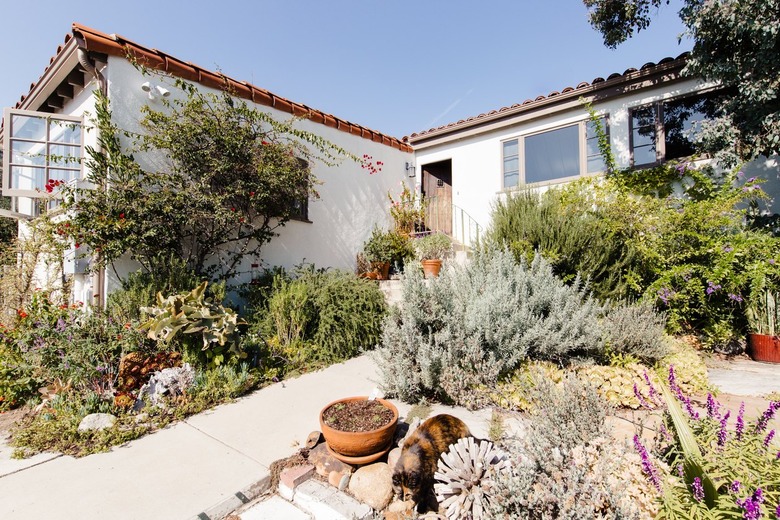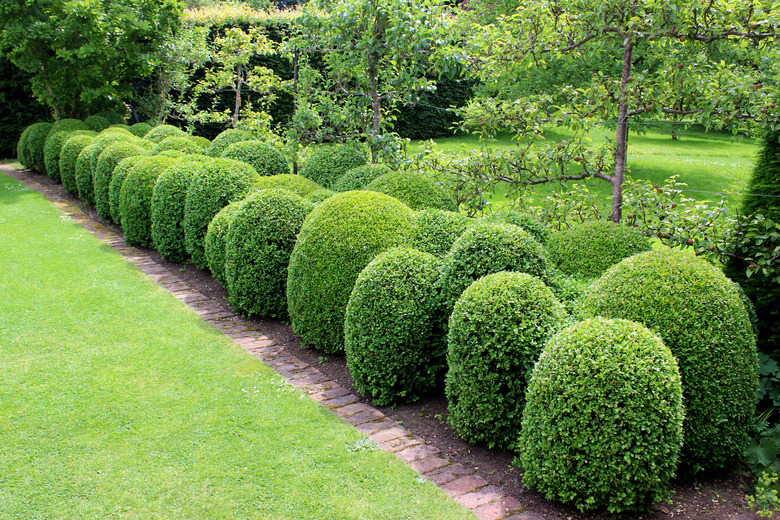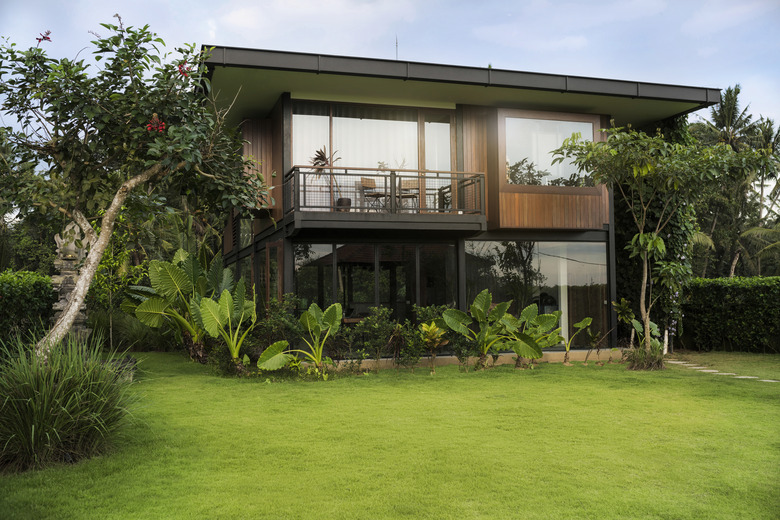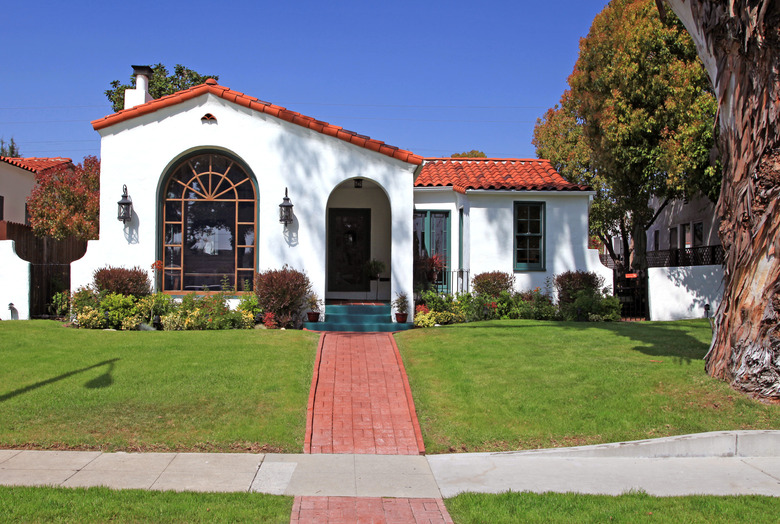A Beginner's Guide To Landscape Shrubs And Trees
We may receive a commission on purchases made from links.
Landscape shrubs and trees are an important part of any yard design. Not only do they provide visual interest but they can also offer privacy and/or serve as a focal point in the landscape design. These plantings offer a number of various heights and shapes instead of just plants and flowers that tend to be low to the ground and look more straightforward.
It's smart to choose low-maintenance plantings for maximum impact with minimum upkeep. There are a variety of different trees and shrubs that work well in residential yards, and there are a number of different factors to consider when choosing them. There's a host of wonderful information online, but working with an established nursery can also be helpful so you can get tips on plants that will thrive in your local area. In addition, many home improvement stores have a garden area that stocks popular tree and shrub varieties at reasonable prices.
Know the Plant Hardiness Zones
Know the Plant Hardiness Zones
It's important to know what landscape shrubs and trees are the best options for the yard before any serious planning begins. There are different plant hardiness zones throughout the United States, and this should be taken into account when laying out any landscape design. The USDA Agricultural Research Service has a detailed plant hardiness zone map that can be searched by state or by zip code. There are 11 different zones throughout North America. Find yours and work from there to get an idea of which plants will survive the winter temperatures in the region.
Matching trees and bushes to the proper hardiness zone will help ensure that the plantings aren't doomed to an annual status. This is especially important when it comes to these landscaping items because they tend to be more costly to replace than ordinary plants or flowers if they don't survive the winter. Besides that, heat, humidity and elevation also play large roles in plant hardiness. It's important to include these factors as well to get the full picture.
The best sources for selecting plantings in any area are local conservatories, horticultural experts or a nearby extension service. They know a lot about native trees and shrubs and can make solid suggestions for choices that will thrive in the immediate area. Be sure to give them an idea of what you are looking for so they can direct you to suitable options.
Sunlight and Water Availability
Sunlight and Water Availability
Along with the hardiness zones, the amount of available sunlight and water in any yard location is an important consideration for shrubs or trees. Some grow better in full sun, while others may fare better in partial or full shade. Certain plants dislike having wet roots, while others may require frequent watering. Putting the right plant in the right spot is one of the underpinning principles of landscape design, and that is for a good reason. Happily planted bushes and trees will grow well and look better than ones that are mismatched with their location in the yard.
A little careful observation is all that is needed to get a feel for the amount of sun each area of the yard receives throughout the day. Keep in mind that structures and other plantings will have an effect on any areas where they cast shade, as will the path of the sun throughout the day. The seasons may lengthen and shorten these time windows as well, so be sure to take that into account when mapping things out.
The type of soil in the yard generally dictates the amount of water it will hold. Sandy soils drain better than ones that are heavy with clay. Loamy soil is the best-possible kind for most plants. Once the soil type is known, it's easier to establish a watering schedule that works well for the trees, bushes and plants in the yard. Some amendments to the soil can also be made if needed to make it more suitable for a particular type of plant.
Keep in mind that any new trees and bushes will require more frequent watering to help them get established properly and to create a successful root system. Be sure to deeply water any new planting so that it develops well and stays healthy. Some homeowners even like to use a slow-release watering bag to provide newly planted trees with consistent moisture. These can be helpful.
Plan for Shrub and Tree Growth
Plan for Shrub and Tree Growth
One of the main factors to weigh in choosing landscape shrubs and trees is the final size of the planting when it is full grown. It's easy to place bushes too close together and then have a spacing problem once they begin to fill in. The same goes for trees. It's fun to pick out a nice-looking ornamental tree, but the planting location has to be considered carefully to make sure it has the room to reach full size comfortably without coming too close to the house or taking over a patio area. Shrubs and trees aren't as easy to move as plants and flowers.
Take the growth patterns of other plants into account as well when selecting bushes or trees. For example, it's not a good idea to plant a shade tree in an area that will grow and cover a bed of sun-loving perennial flowers. Tall bushes might look better with a low ground cover in front of them. Keep in mind the big picture of the landscape design to help inform final placement. When possible, it can be helpful to lay out the trees and bushes first and then add other ornamental plants and flowers as needed.
Tree Selection Tips
Tree Selection Tips
To find the right tree for a particular space, it helps to think through how it will be used. Some trees are planted for shade, while others may be purely ornamental. Shade trees should grow tall enough to provide some cover, so be sure to check the final height and branch spread to determine if it works in the area where it will be planted. Also take into consideration the distance from the house, garage, power lines or other structures before mapping out the final location.
Ornamental trees add a decorative touch to the landscape and create a focal point in the overall design. One dramatic example is the ever-popular magnolia tree (Magnolia spp.), with its large, fragrant blossoms of different sizes, shapes, and colors (depending on species) that appear in the early spring or summer. Dogwood trees (Cornus spp.) are another must have for many homeowners, and they feature delicate pink or white flowers. Another spring bloomer, the dogwood is hardy and a pretty fast grower, making it a good choice for any yard.
The American yew (Taxus canadensis, USDA zones 3-7) is an evergreen, making it attractive in some of the winter climates where other trees may not provide any visual interest. It also produces red berries that serve as food for birds (however, all parts of the yew tree are toxic to humans). Again, the amount of sun and the plant hardiness zone will need to be determined to narrow the field with any tree being considered. The Arbor Day Foundation website offers a helpful "tree wizard" that asks a few questions and then recommends the best tree based on the answers provided. This can be a good starting place to get a feel for the options.
Shrub Selection Tips
Shrub Selection Tips
As with trees, some thought should be given to the purpose of the bushes in the landscape design. Sometimes, shrubs are planted to help enhance privacy or to line a walkway. If this is the case, it will be critical to know how large these bushes will grow in order to make sure the spacing is right when they are planted. Typically, shrubs that are planted as a privacy screen will take some time to fill in and serve their purpose.
One of the most popular picks is the sunlight-loving Little Gem arborvitae (Thuja occidentalis 'Little Gem,' USDA zones 2-7). This evergreen shrub reaches only 3 feet tall, unlike the species arborvitae (Thuja occidentalis) that reaches towering heights up to 60 feet. Little Gem will fill in nicely in just a couple of years, making it a good choice as a new planting. Another favorite is barberry (Berberis spp.), which comes in a variety of different colors, such as purple, red or yellow. Choose a dwarf barberry, such as Berberis buxifolia 'Nana' (USDA zones 6-9) which reaches only 12 inches high, if you want a low-growing shrub to plant as edging in front of taller shrubs because some barberries reach heights of 10 feet or more, depending on species and cultivar. Barberry plants make a great accent in any yard, and they can also be used as hedges or as foundation plantings, depending on species and cultivars. They work well as a barrier plant because they have small thorns.
If an attractive-looking shrub is the goal, there are many different flowering plants from which to choose. Azaleas (Rhododendron spp.) are easy to care for and provide a burst of colorful blooms to the landscape. According to the Azalea Society of America, the majority of these shrubs bloom in the spring. Another spring bloomer is the lilac bush (Syringa spp.), with its fragrant, delicate groupings of flowers. This shrub can be tall (to 16 feet) or short (3 feet), depending on species and cultivar, so choose one that suits its intended growing spot. Sweet-smelling gardenia blooms (Gardenia jasminoides) are another great choice for scent, blooming in late spring to early summer. Gardenia shrubs grow from 2 to 8 feet, depending on cultivar.
Those looking for a bush with impressive late-summer flowers might want to consider the rose of Sharon (Hibiscus syriacus, USDA zones 5-9), which comes in a number of different colors and can grow 6 to 12 feet in height, offering a dramatic wall of flowers. Hydrangeas (Hydrangea spp.) are another easy-to-grow shrub that provides stunning groupings of flowers, some with the color dependent on the soil pH. Other attractive bushes worth consideration include viburnum (Viburnum spp.), boxwood (Buxus spp.) and rhododendrons (Rhododendron spp.), all of which work well for first-time gardeners.
Caring for Landscape Shrubs and Trees
Caring for Landscape Shrubs and Trees
Upkeep is another factor to consider. Low-maintenance plantings are less time-consuming to deal with on a regular basis. Although most trees and bushes will require some type of shaping, trimming or pruning, it's good to know the amount of work each will take before adding them to the landscape design. Not all bushes and trees will always follow the same care plan. Keep cleanup in mind as well. Any plantings that drop seeds or flowers may necessitate some extra time in the yard to keep things looking tidy.
Young trees may need to be pruned more frequently than older ones to assist in their growth and to provide some shape. Many varieties should be pruned before spring to help them heal well and to remove any dead branches. Be sure to check and see what the recommendations are for the individual tree, as some will have different instructions than others. Improper tree pruning can lead to problems like disease and an infestation of pests.
Bushes tend to need some gentle shaping and pruning to remove dead pieces and keep them looking good. Try to follow the natural shape of the plant when possible and don't overdo it the first year after planting. Let the shrub get established a bit first. Generally, the rule of thumb is to prune in the late winter or early spring before the bush begins growing but always check information about the particular plant to make sure that is the right time before cutting off any branches.



